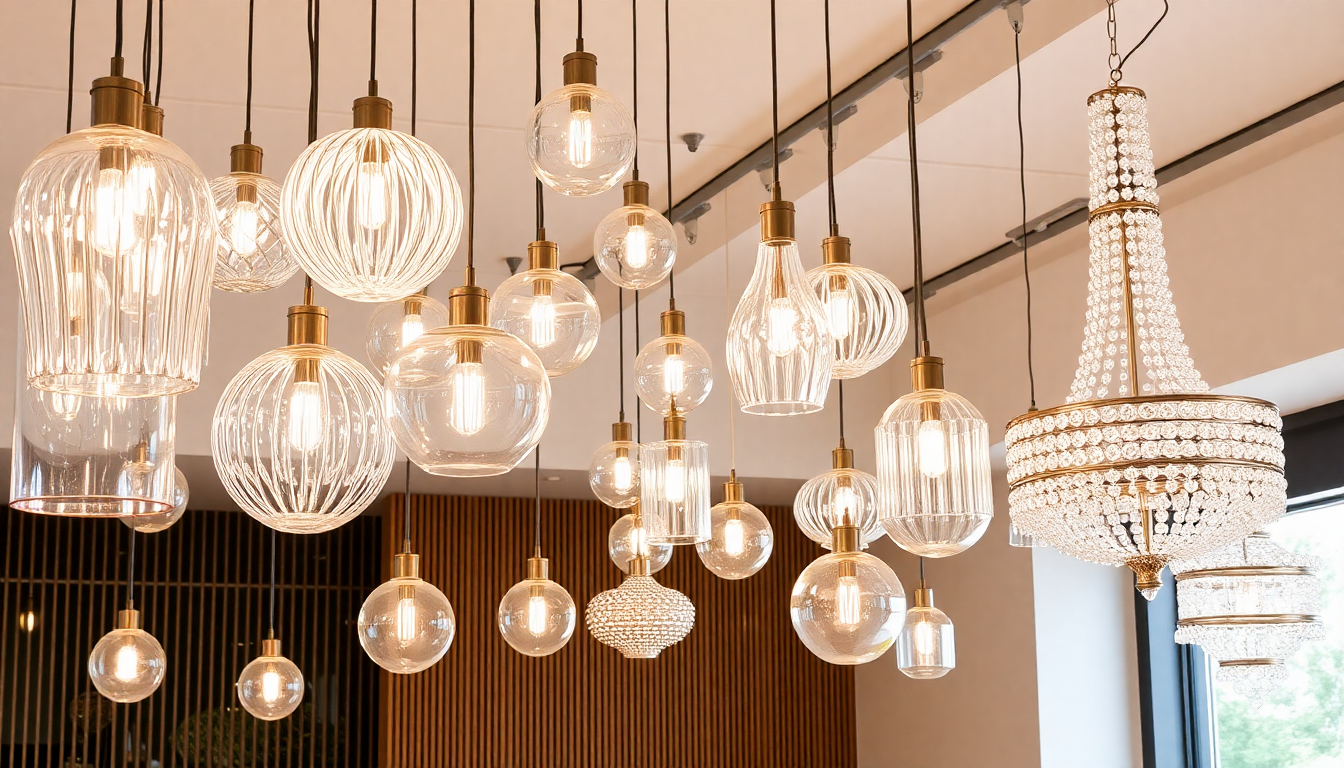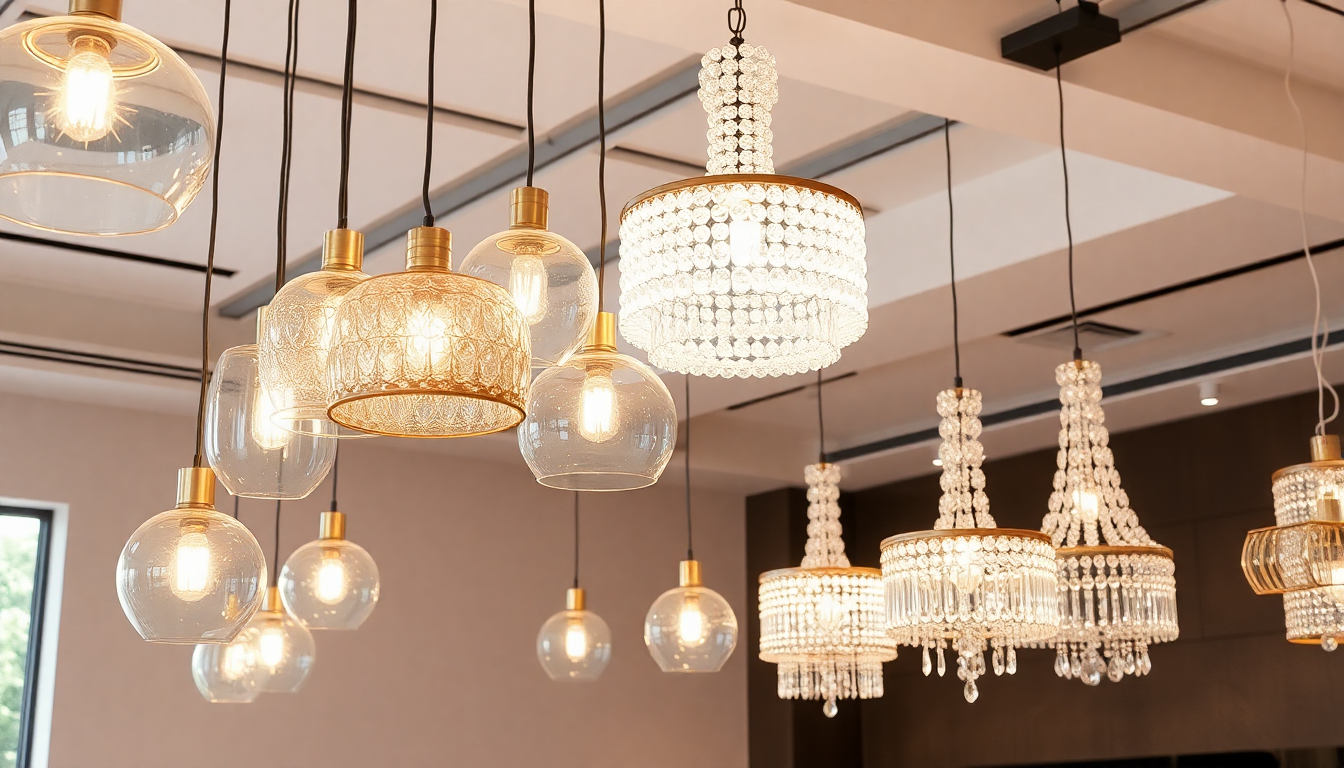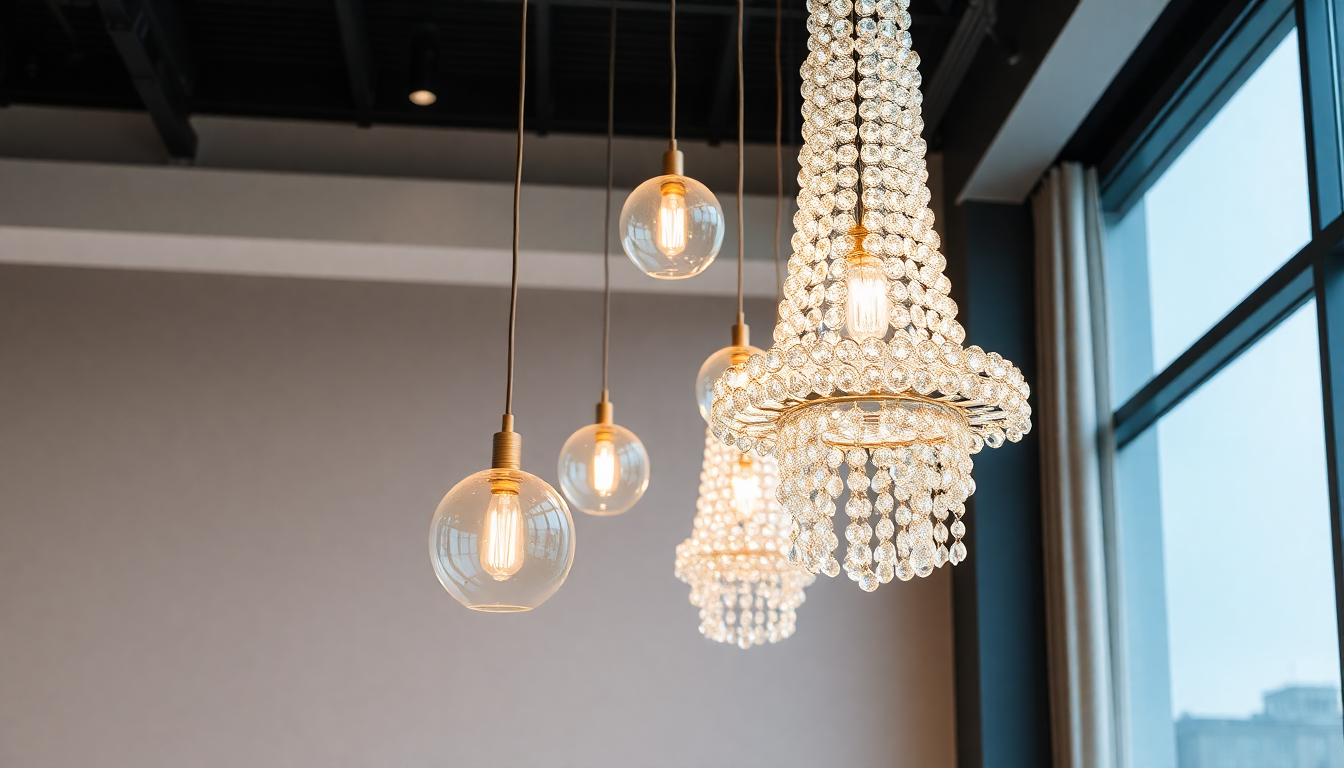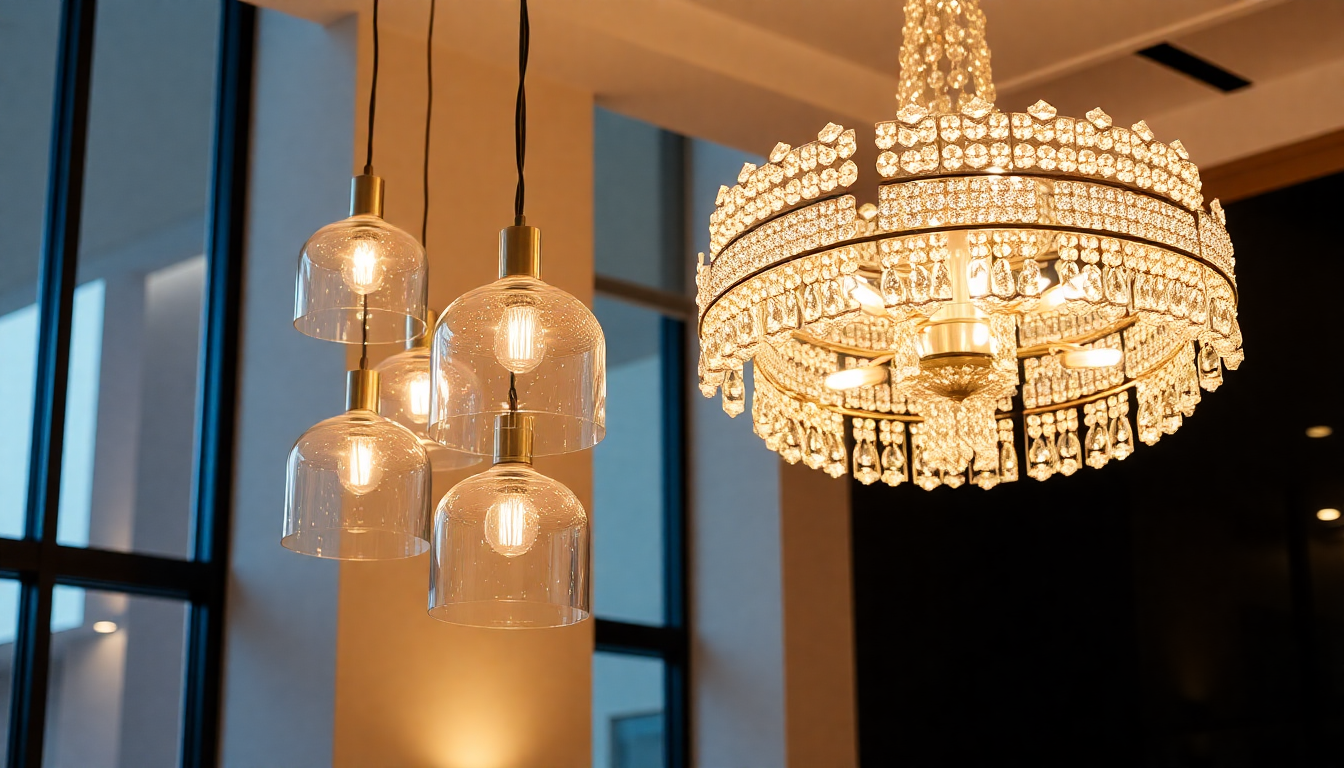Introduction — The Art and Science of Lighting
Glass pendant lights and crystal chandeliers are more than fixtures: they shape atmosphere, define focal points, and influence perceived space. Getting the bulb warmth, finish and glass type right turns lighting from an afterthought into a design statement. This comprehensive guide covers technical specifics, creative styling, installation and maintenance, shopping checklists, and a curated selection of glass pendant lighting and crystal chandelier options to help you make confident choices. Target keywords for this guide include glass pendant lights, glass pendant lighting, milk glass pendant light, stained glass pendant light, and blown glass pendant lights.
How Bulb Warmth Changes Perception of Glass
Bulb warmth is measured in Kelvin (K) and dictates whether light reads warm and cozy or cool and clinical. The same fixture can look dramatically different with different Kelvin selections.
- 2200K–2700K (Very Warm to Warm White): Produces a golden, amber glow. Ideal for living rooms, dining rooms and bedrooms. Milk glass pendant light shades take on a soft, inviting radiance at these temperatures and crystal chandeliers have a warm, sparkling quality.
- 3000K–3500K (Warm-white to Neutral): A versatile range for kitchens, bathrooms and general living zones. Blown glass pendant lights with slight color variations render accurately and pleasantly here.
- 4000K–5000K (Cool-white to Daylight): Preferred for task-heavy areas or commercial settings. Stained glass pendant light colors can look more saturated under higher Kelvin bulbs, though cooler bulbs may feel less intimate in residential rooms.
Practical tip: use dimmable LEDs to shift effective warmth with dimming. Many modern LEDs emit warmer light when dimmed, mimicking incandescent behavior and improving ambience control for mixed-use spaces.
Finish Coordination: Metals, Mounts and Visual Weight
Finish selection ties fixtures into room decor. Consider the visual temperature of metal finishes along with bulb warmth and glass color.
- Brass, Warm Gold and Aged Brass: Complement milk glass pendant light shades and add a luxe feel. Brass warms clear glass and crystal, creating a vintage or mid-century modern look.
- Polished Chrome and Satin Nickel: Modern and reflective, these finishes pair with clear blown glass pendants and contemporary crystal chandeliers for crisp, polished interiors.
- Matte Black and Bronze: Provide contrast and graphic framing. These finishes work well with stained glass pendant light fixtures in eclectic and industrial schemes.
- Antique and Patina Finishes: Great for historic restorations or cottage and boho styles, enhancing the artisanal charm of hand-blown glass.
Decor tip: pick one dominant finish in the room and use a secondary finish sparingly for accents. This creates visual cohesion without monotony.
Glass Types Demystified
Each glass type behaves differently with light and will affect glare, diffusion and color rendering.
- Milk (Opal) Glass: Opaque and uniform, milk glass pendant light shades diffuse light smoothly, minimize hotspots and are forgiving of bulb imperfections. Perfect for bedside, bathroom, and soft ambient light needs.
- Stained Glass: Adds color, pattern, and handcrafted charm. Stained glass pendant light fixtures make strong visual statements in entryways, dining rooms, or as accent pendants. Expect more variation and artisanal uniqueness.
- Blown Glass: Produced by glassblowers, blown glass pendant lights can include irregularities, swirls and air bubbles that add character. They work beautifully in clusters or as single statement pieces over islands and bars.
- Frosted or Etched Glass: Semi-translucent, offering gentler diffusion than clear glass while still permitting subtle shaping of the light source within.
- Clear Glass: Maximizes brightness and reveals bulb detail and crystal facets. Use with attractive bulbs (LED filaments) or when you want light to feel open and bright.
Room-by-Room Guide: Choosing Glass Pendant Lighting & Chandeliers
Different rooms require different lighting strategies. Below are concrete recommendations for common spaces.
Kitchen
- Over islands and counters: use 3000K neutral white for balance between task and atmosphere. Blown glass pendant lights in a row or cluster create a pleasing rhythm and visual anchor.
- Task areas: clear glass pendants with LED filament bulbs if you want strong, focused light. Use dimmers to reduce glare when task intensity is lower.
- Finish match: stainless steel appliances pair well with chrome or satin nickel fixtures; warm wood or brass accents pair nicely with brass-finished pendants.
Dining Room
- Select a central chandelier or linear pendant above the table; 2700K to 3000K creates an inviting dining atmosphere.
- Chandelier size: add length and width of room in feet and convert to inches for an approximate chandelier diameter. For example a 10x12ft room suggests roughly a 22in chandelier.
- Consider a stained glass pendant light for a dramatic, colorful focal point in traditional settings.
Living Room
- Layer lighting: combine a statement crystal chandelier or large blown glass pendant with recessed lights or table lamps. Use warm white bulbs for cozy ambiance.
- Milk glass pendant light fixtures can serve as elegant side lighting near seating areas.
Bedroom
- Use milk glass or frosted pendants as bedside lighting to replace traditional lamps and free up surface space. 2700K bulbs help with relaxation.
- Consider smaller blown glass pendants with adjustable hanging height for flexibility.
Bathroom
- Avoid direct glare near mirrors: frosted or milk glass provides flattering, diffuse light for grooming. Use higher CRI bulbs where color accuracy matters.
- Check damp/wet location ratings for fixtures before installing in showers or near tubs.
Entryway and Staircases
- Go big with blown glass pendants or a tiered crystal chandelier to create an immediate impression.
- Consider multi-level pendant arrangements for high ceilings to populate vertical space.
Bulb Types, CRI and Lumen Guidance
Understanding bulbs is essential when selecting glass pendant lights and crystal chandeliers.
- LED: Most efficient and long-lasting. Choose LEDs with a high CRI (90+) for accurate color rendering, especially important with stained glass pendant light fixtures.
- Filament-style LEDs: Offer vintage looks while maintaining LED efficiency. Ideal in clear glass pendants to create visual interest.
- Lumen Guidance: For general ambient lighting, plan roughly 100–200 lumens per square meter as a starting point. For task lighting like kitchen counters, increase to 300–500 lumens per square meter.
- CRI (Color Rendering Index): Choose CRI 90+ for kitchens, bathrooms, and areas with stained glass so colors remain vibrant and true.
Dimmers, Smart Controls and Layered Lighting
Modern lighting benefits from control systems that adjust mood, efficiency and functionality.
- Dimmers: Use compatible ELV or trailing-edge dimmers with LED bulbs for smooth dimming and to avoid flicker. Dimming allows warm-white LEDs to recreate incandescent ambiance.
- Smart Bulbs and Hubs: Smart LEDs let you adjust Kelvin, color and brightness via app, voice or automation, enabling multifunctional rooms with a single fixture type.
- Scene Setting: Program scenes for dining, working, entertaining and relaxing. Scene control is especially effective with crystal chandeliers, where sparkle can be nudged up or down.
Installation Basics and Safety
- Turn off power at circuit breaker before any installation or bulb change.
- Confirm junction box capacity and mounting hardware matches fixture weight, especially for heavy blown glass pendants or crystal chandeliers.
- Hire a licensed electrician for complex installs, island drops, or when adding new circuits or dimmers.
- Confirm wet/damp ratings for bathroom and exterior mounts.
Cleaning and Maintenance
Glass and crystal require regular care to maintain clarity and sparkle. Here are practical maintenance steps.
- Turn off power and allow bulbs to cool before cleaning.
- Use a lint-free microfiber cloth and a mild glass cleaner. For delicate crystal pieces, a 50/50 mix of distilled water and isopropyl alcohol reduces streaks.
- For milk glass or frosted finishes, avoid abrasive cleaners which can dull the surface; use mild soap and water instead.
- Inspect mounts and wiring periodically for wear, and replace bulbs with like-for-like wattage and base type to avoid overheating.
Styling Strategies: Minimalist, Contemporary and Eclectic Interiors
Styling lighting is about balance: scale, repetition and restraint create harmony. Below are curated stylistic strategies for different interiors.
Minimalist Interiors
- Choose simple blown glass pendant lights with clear or opal glass and slim hardware. Keep colors neutral and use even spacing to emphasize order.
- Use matte finishes such as black or white for subtle contrast and to maintain a calm palette.
Contemporary Interiors
- Incorporate mixed materials like glass with metal rods or leather accents. Polished chrome or nickel with clear glass pendants gives a modern, shiny aesthetic.
- Consider asymmetrical cluster arrangements of blown glass pendant lights for an artful focal point.
Eclectic and Vintage Interiors
- Choose stained glass pendant light fixtures or antique brass finishes to highlight personality and craft. Mix in a statement crystal chandelier as a contrasting luxe accent.
- Vary pendant heights and shapes while keeping a unified finish to avoid visual chaos.
Mixing and Matching: A Practical Guide
Mixing different glass types and finishes is powerful but can be tricky. Use these rules:
- Anchor with a dominant element: choose room's primary metal finish and repeat it in 60–70% of fixtures and hardware.
- Unify with bulb warmth: even with different glass styles, matching Kelvin keeps spaces cohesive.
- Vary scale intentionally: use a single larger statement pendant paired with smaller accents to create hierarchy.
Statement Pieces: Making Your Lighting the Focal Point
To make a fixture the star of the room:
- Prioritize scale: a larger-than-expected blown glass pendant or a tiered crystal chandelier can dominate a room and anchor furniture layout.
- Coordinate placement: center over dining tables, island counters or living room seating to ensure the fixture draws attention.
- Invest in craftsmanship: hand-blown glass or cut crystal details typically provide the long-term wow factor.
Budget Strategies — Achieving Luxury on a Shoestring
You can achieve a luxe look without a huge budget by selecting high-impact components.
- Choose fixtures with premium finishes like brass-tone plating and good glass quality rather than full-precision crystal.
- Use multiple budget-friendly glass pendants in a grouped cluster for a more expensive layered look.
- Invest in good bulbs and dimming controls; lighting quality is as important as fixture price.
Shopping Checklist — What to Confirm Before Purchase
- Fixture dimensions and weight, including canopy size and maximum hanging length.
- Glass type and whether shades are replaceable or fixed.
- Bulb type compatibility, recommended Kelvin range and CRI.
- Mounting hardware and whether electrician installation is recommended.
- Finish consistency and return policy for finish or glass variations.
- Safety rating for damp or wet locations when applicable.
Glossary of Terms
- CRI: Color Rendering Index, measures light source's ability to reveal colors accurately.
- Kelvin: Unit measuring color temperature of light; lower = warmer, higher = cooler.
- Junction Box: Electrical box in the ceiling that supports and supplies power to fixtures.
- ELV: Electronic Low Voltage dimmer, often used with LED drivers for smooth dimming.
Curated Buy Links — Glass Pendants & Crystal Chandeliers
Below are curated product suggestions organized by glass type and style. These buy links and images are intended as starting points to help you explore glass pendant lighting and crystal chandelier options.
-
Milk Glass Pendant Light — Opal Globe Pendant
Buy Milk Glass Pendant

Ideal for bedside pendants or pendant clusters above a kitchen counter; diffuse light with minimal glare.
-
Stained Glass Pendant Light — Tiffany Style
Buy Stained Glass Pendant

Handcrafted look that adds color and craft warmth to entryways and dining rooms.
-
Blown Glass Pendant Light — Handblown Teardrop
Buy Blown Glass Pendant

Perfect over kitchen islands or as a trio above a breakfast bar; each piece shows unique bubbles and swirls.
-
Clear Glass Pendant Lighting — Modern Globe Cluster
Buy Clear Glass Pendant

Great for modern dining spaces where bulb filament beauty is part of the look.
-
Crystal Chandelier — Contemporary Multi-arm
Buy Crystal Chandelier

A statement fixture for large dining rooms or grand entryways; choose warm white bulbs for a refined sparkle.
-
Linear Farmhouse Pendant — Frosted Glass Bar
Buy Linear Frosted Pendant

Works well over long islands; frosted glass reduces glare while providing even task lighting.
-
Mini Blown Glass Cluster — Assorted Colors
Buy Mini Blown Glass Cluster

Create a curated-art look with mixed colors and heights; excellent for contemporary and eclectic interiors.
-
Artisan Stained Pendant — Floral Motif
Buy Artisan Stained Pendant

Hand-soldered details and vibrant glass choices create a focal conversation piece.
-
Retro Globe Pendant — Milk Glass with Brass
Buy Retro Milk Glass Pendant

Budget-friendly luxe look combining opal glass with warm brass tones.
-
High-Glitz Crystal Tiered Chandelier
Buy Tiered Crystal Chandelier

For truly grand spaces; consider professional installation given weight and height considerations.
Real-World Styling Examples and Case Studies
Below are short case examples showing how choices play out in real rooms.
Case Study 1: Minimalist Kitchen with Blown Glass
Challenge: small kitchen island needs task light without visual clutter. Solution: three hand-blown clear glass pendant lights with satin nickel hardware and 3000K LEDs. Result: bright task light, elegant and unobtrusive profile, and a sense of openness due to transparent glass.
Case Study 2: Cozy Dining Room with Milk Glass and Brass
Challenge: create warm, intimate dining experience. Solution: pendant cluster of milk glass opal globes on brass stems, dimmable 2700K bulbs. Result: even, warm illumination flattering to faces and table settings; luxe vibe at moderate cost.
Case Study 3: Eclectic Entryway with Stained Glass and Crystal
Challenge: big entryway feels cold. Solution: combine a mid-sized stained glass pendant light over the console with a small crystal chandelier in adjacent niche, unify finishes with antique brass accents. Result: color and sparkle create a layered, curated entry experience.
Frequently Asked Questions (FAQs)
-
Q: Can I mix different glass pendant lights in one room?
A: Yes, if you maintain a consistent finish and bulb warmth and limit the palette to two glass types to avoid visual clutter. -
Q: What is the best bulb for crystal chandeliers?
A: Warm white LEDs with high CRI (90+) and small form factors work best to showcase crystal sparkle without harshness. -
Q: How do I keep blown glass pendants safe from breaking?
A: Mount them with secure hardware, avoid overtightening, and keep them away from heavy traffic paths. Use anchored junction boxes for heavier pieces. -
Q: Are stained glass pendant lights energy efficient?
A: Energy efficiency depends on bulb type. Use LED bulbs to maintain energy-efficient performance regardless of glass style.
Final Thoughts — Make Intentional Lighting Choices
Glass pendant lighting and crystal chandeliers are investments in atmosphere and aesthetics. Matching bulb warmth, finish and glass type is the triad of decision-making that ensures fixtures flatter your space and perform well. Whether you choose a milk glass pendant light for soft ambient glow, a bold stained glass pendant light for color and craft, or blown glass pendant lights for unique form and texture, thoughtful pairing with bulbs, finishes and placement will deliver a room that looks and feels cohesive.
Use the curated links above as a starting point. Measure, consider bulb and dimmer compatibility, and when in doubt consult a lighting specialist or electrician for installation guidance. Good lighting transforms spaces — choose intentionally and enjoy the glow.
Further Resources
- Guide to Choosing the Right Bulb: Kelvin, CRI and Lumens
- How to Install and Wire a Ceiling Pendant Safely
- Cleaning and Care for Glass and Crystal Fixtures




